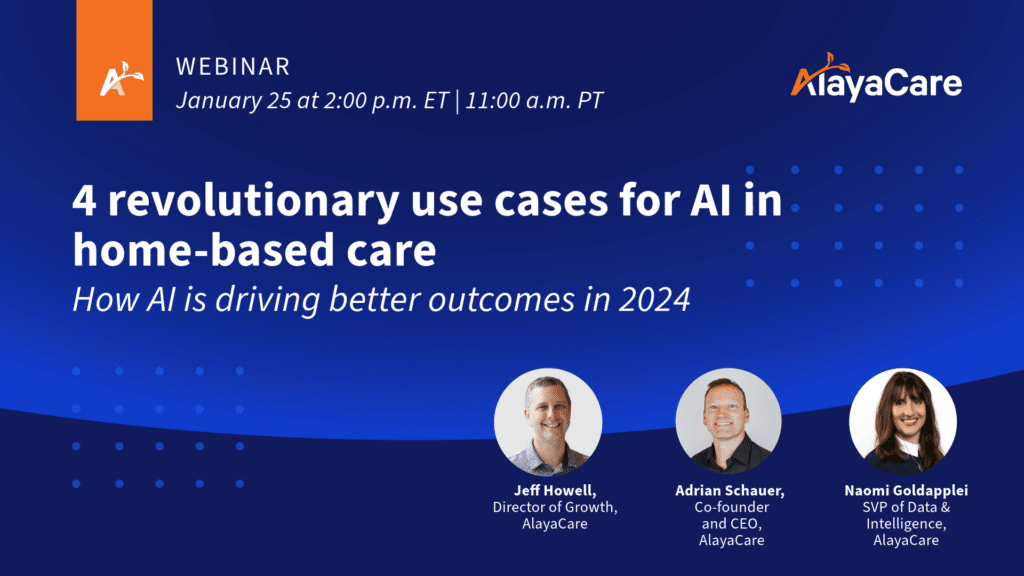Blog
Embracing AI technology to recruit and retain caregivers: HHCN’s Continuum panel highlights

Artificial intelligence (AI) has been around for decades — since 1956, to be exact. However, the recent emergence of OpenAI, ChatGPT, and other large language models (LLMs) have catapulted this technology into the collective consciousness. Now, many in home-based care are wondering how AI can be leveraged in operations, primarily to tackle the ongoing challenge of caregiver churn.
So, it came as no surprise when AI and caregiver churn arose as trending topics at the latest Home Health Care News Continuum Conference. During a conference panel, subject experts Sarah Khalid, Product Manager, and Guillaume Vergnolle, Senior Data Scientist at AlayaCare were invited to share how providers can leverage AI to maximize retention in an industry-wide labor shortage.
Read on to discover the top panel highlights around embracing technology at your organization.
Why embrace AI to reduce caregiver churn?
It’s no secret that caregiver churn has become a significant issue within the home health industry. Sarah cites recent reports of 64% turnover rates for caregivers and nurses in the field and 40% turnover rates for office staff. Technology has revealed a potential source for the ongoing churn.
“Scheduling is often the number one reason why caregivers get particularly disgruntled,” Sarah explains of recent AI-powered findings. “A lot of their preferences aren’t being respected when it comes to some of the hours that they want to work and some of the cases that they want to work.”
“What some of these technologies can do is help come up with an optimal schedule that not only respects the capacity that is desired but also perhaps some of the skills that they’re more accustomed to working and some of the types of shifts that they would also like to receive.”
Guillaume points out that several data points indicate whether caregivers are receiving the proper volume of service as expressed in their availability or contract, which AI monitors over time. He also mentions that surveys and sentiment analysis can predict caregiver churn before it even happens.
“We can use another set of LLMs and machine learning to pick up on different patterns [in caregiver documentation],” Sarah explains. “We can pick up on sentiment when they are leaving those notes, and that gives us clues into how they’re feeling and how those feed into retention as well.”
What’s the potential for technical challenges?
The home health care sector is relatively slow-moving when it comes to adopting technology, which can, believe it or not, exacerbate challenges in caregiver recruitment and, ultimately, retention.
“When we’re tackling some of these retention problems, a lot of the time the data is being stored in so many different places. We see a lot of different owners that are storing their data in Google Docs, or Excel, or in a bunch of different sources,” Sarah reveals. “The challenge is not just in making sure that the data that’s being collected is of quality but making sure that all of that data is harmonized.”
Sarah and Guillaume share that many LLMs are forgiving of spelling errors and similar data quality issues, but it’s the gathering and storing of data that’s the most problematic in terms of technical challenges. To circumvent these issues, both recommend sourcing flexible and secure AI solutions.
Where to start implementing AI technology?
When we say “flexible and secure AI,” we do not mean ChatGPT. “The industry we’re in, our data is extremely sensitive. When we begin to experiment with a lot of these large language models and play with ChatGPT, this is something that can result in data leaks and breaches,” Sarah explains.
Instead, it’s vital to source technology that not only supports caregiver retention but also safeguards data. “In our field, we need to build our own guardrails to prevent [data leaks],” Guillaume shares. “Make sure that the workflows that we’re designing are not very foreign to the current practices.”
Take AlayaCare’s Notable, for example. Powered by a type of artificial intelligence called natural language processing (NLP) algorithms, Notable uses AI to detect important information, like caregiver sentiment, in the patient documentation and notes caregivers are already completing.
This advanced technology relies on the information input by caregivers, meaning it’s not actively scouring the web — or sharing patient details — to work its magic. Instead, Notable applies predictive analytics to the caregiver-provided notes to determine the probability of caregiver churn.
Looking to the future of AI with end-to-end home care software
It’s vital to point out that while AI can do a lot of the heavy lifting for identifying the potential for caregiver churn, the onus is still on owners and operations leaders to increase caregiver retention.
“Ask yourself the question, ‘What would be the right tool to solve this problem?’ AI could be a part of the answer. It is a part of the process, but it is not the entire thing,” explains Guillaume.
“Artificial intelligence is not meant to be a replacement tool, but it’s meant to be decision support. Throughout the entire process — when we’re training and we’re building and we’re syncing up how AI can be used — we are considering the process of the human being in the loop,” adds Sarah.
LIVE WEBINAR
4 revolutionary use cases for AI in home-based care
How AI and machine learning are driving better outcomes in 2024
Thursday, January 25 at 2 pm ET
Join us for this special webinar to explore:
- Real-world applications for artificial intelligence (AI), machine learning (ML), generative AI, and optimization algorithms for home-based care
- 4 compelling use cases powered by AI and ML and how these examples are impacting clients, caregivers, and agencies
- How your organization can start utilizing these technologies to yield remarkable results
- Plus, time for live Q&A with our expert speakers





